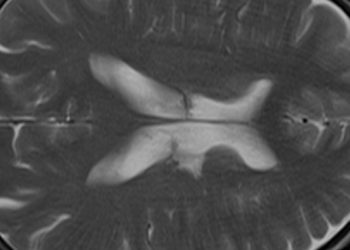Lifetime exposure to depression is associated with alterations in neural connectivity observed on functional magnetic resonance imaging
1. Lifetime exposure to depression in adults was correlated to decreases in global and local neural connectivity on functional magnetic resonance imaging (fMRI).
2. Definitions of depression that were associated with the strongest functional alterations included meeting criteria for diagnosis with the International Statistical Classification of Diseases (ICD-10) and use of antidepressants.
Evidence Rating Level: 2 (Good)
Study Rundown: Major depressive disorder (MDD) is among the most common mental health disorders around the globe, affecting at least ten percent of people over the lifespan worldwide. Although decades of neuroimaging research have been put towards quantifying the structural and functional alterations in the brain associated with depression, data remains inconclusive. One reason for this lack of convergence in the data, according to the current study authors, is due to the differences in the operationalization of depression between these studies. This cross-sectional study investigated data from 45,946 adults in the UK Biobank (20,484 meeting at least one criteria for lifetime exposure to depression, and the remainder as healthy controls), and sought to study neuroimaging results while stratifying patients using 6 different operational criteria of lifetime exposure to depression. Functional MRI and T1-weight structural images were the imaging modalities of choice. Overall, the study found that, compared to healthy controls, those with all constellations of exposure to lifetime depression demonstrated functional alterations as well as decreases in local activity and in global connectivity measures. The strongest effect sizes in functional change and decreased grey matter volume were seen in those who met ICD-10 diagnosis codes and in those who used antidepressants. The results of the study suggest that there could be a functional phenotype of brain function in persistent depression, but effect sizes are small to moderate.
Click to read the study in JAMA Network Open
Relevant Reading: Multimodal abnormalities of brain structure and function in major depressive disorder: a meta-analysis of neuroimaging studies
In-Depth [cross sectional study]: In the context of exploring the long-term effects of depression on brain structure and function, the prevalence and impact of depression on global health have been well-documented with significant implications for cognitive and emotional processing. Despite considerable research, the specific alterations in brain morphology and connectivity associated with cumulative exposure to depression remain relatively poorly understood. The current study sought to explore how six different operationalized definitions of lifetime depression exposure influenced brain structure and function: 1) help seeking for depression; 2) self-reported depression; 3) antidepressant use; 4) depression definition by Smith et al; 5) hospital International Statistical Classification of Diseases and Related Health Problems (ICD-10) diagnosis codes; and 6) composite International Diagnostic Interview Short Form score. The cross-sectional study analyzed data from over 45,000 participants aged 45-80, with 20,484 of which meeting at least one of the six definitions of lifetime exposure to depression (mean [SD] age 63.91 [7.60] years; mean (SD) years of education 16.65 [3.82]. An additional 25,462 healthy controls were included for comparison. Neuroimaging data from high-resolution functional magnetic resonance imaging (fMRI) scans assessed variations in brain structure and function. Participants were selected based on their medical history, including documented episodes of depression, and were stratified into groups with varying degrees of exposure to depression. Data collection focused on changes in gray matter volume, white matter integrity, and functional connectivity. Findings revealed that, when compared to healthy controls, individuals meeting at least one of the definitions of lifetime depression exposure demonstrated significant reductions in fractional amplitude of low-frequency fluctuation (fALFF), global correlation (GCOR), and local correlation (LCOR) (Cohen d range, −0.53 [95% CI, −0.88 to −0.15] to −0.04 [95% CI, −0.07 to −0.01]). Brain regions involved in functional alterations included the prefrontal cortex, middle temporal cortex, fusiform gyrus, occipital cortex, and cerebellum (p < .001). GMV was found to be decreased in the hippocampus and superior temporal cortex (t22389 = 6.86; P < .001). Interestingly, meeting criteria for ICD-10 diagnosis, as well as antidepressant use, were associated with the strongest changes to brain function. Using these findings, researchers suggest the existence of tangible neurobiological consequences of prolonged depression, underscoring the necessity for early and effective treatment strategies. It also highlights the potential for targeted therapeutic interventions. However, the observational and cross-sectional nature of the study limits its ability to infer causality, pointing to the need for longitudinal research to elucidate the temporal dynamics between depression and structural and functional changes.
Image: PD
©2024 2 Minute Medicine, Inc. All rights reserved. No works may be reproduced without expressed written consent from 2 Minute Medicine, Inc. Inquire about licensing here. No article should be construed as medical advice and is not intended as such by the authors or by 2 Minute Medicine, Inc.







